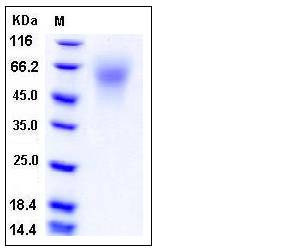Mouse C4.4A / LYPD3 Protein (His Tag)
2310061G07Rik,C4.4a
- 100ug (NPP3191) Please inquiry
| Catalog Number | P50546-M08H |
|---|---|
| Organism Species | Mouse |
| Host | Human Cells |
| Synonyms | 2310061G07Rik,C4.4a |
| Molecular Weight | The recombinant mouse LYPD3 consists of 266 amino acids and has a predicted molecular mass of 28 kDa. The apparent molecular mass of rmLYPD3 is approximately 55-60 kDa in SDS-PAGE under reducing conditions. |
| predicted N | Leu 33 |
| SDS-PAGE |  |
| Purity | > 92 % as determined by SDS-PAGE |
| Protein Construction | A DNA sequence encoding the N-terminal segment of mouse LYPD3 (NP_598504.1) (Met 1-His 287) was expressed, with a polyhistidine tag at the C-terminus. |
| Bio-activity | Measured by its ability to bind recombinant human Galectin3 in a functional ELISA. |
| Research Area | Developmental Biology |Metabolism |Pathways and Processes |Metabolic signaling pathways |Lipid and lipoprotein metabolism |Lipases | |
| Formulation | Lyophilized from sterile PBS, pH 7.4 1. Normally 5 % - 8 % trehalose, mannitol and 0.01% Tween80 are added as protectants before lyophilization. Specific concentrations are included in the hardcopy of COA. |
| Background | Ly6 / PLAUR domain-containing protein 3, also known as GPI-anchored metastasis-associated protein C4.4A homolog, Matrigel-induced gene C4 protein, MIG-C4 and LYPD3, is a cell membrane protein which contains two UPAR/Ly6 domains. Human LYPD3 contains two UPAR/Ly6 domains. LYPD3 is expressed in placenta, skin and urothelium. It is found in suprabasal keratinocytes of chronic wounds. Weak expression of LYPD3 is found in esophagus and peripheral blood mononuclear cells. It is found in the majority of primary and metastatic transitional cell carcinomas (TCCs) and as well in breast cancer tissues, but not in adjacent normal tissues. High expression of LYPD3 is found in the tumor component of some noninvasive superficial lesions and in invasive and metastatic urothelial cancers. LYPD3 is up-regulated in migrating keratinocytes during epithelisation of incisional skin wounds. LYPD3 supports cell migration. It may be involved in urothelial cell-matrix interactions. It may also be involved in tumor progression |
| Reference |
